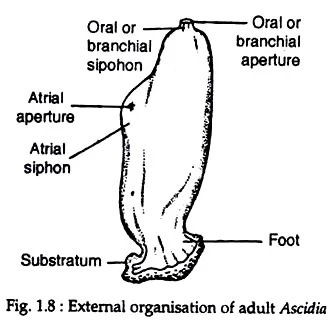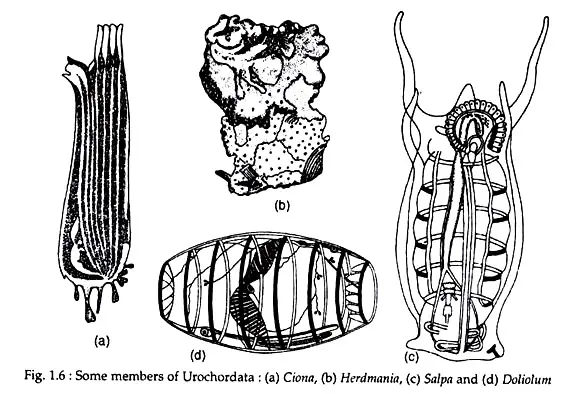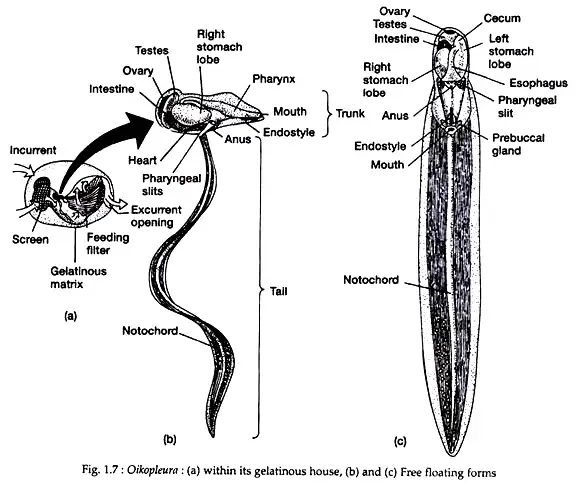- Urochordata, also known as Tunicates or Sea Squirts, is a subphylum of the Phylum Chordata. These marine filter-feeding invertebrates are found in seawater and play an essential role in marine ecosystems. They have a unique life cycle, with distinct characteristics exhibited by their larvae and adults.
- In the larval stage, Urochordata possesses all the typical chordate features. They have a notochord, a dorsal nerve cord, pharyngeal slits, and a post-anal tail. The tadpole-like larvae are free-swimming, allowing them to move through the water and explore their surroundings. However, as they mature, significant changes occur.
- Upon reaching adulthood, Urochordata undergoes a transformation. The body structure becomes much simpler, resembling a protective sac with two siphons. These siphons serve as openings through which water enters and exits the body. Water is filtered inside the sac-shaped structure, allowing the tunicate to extract nutrients from planktonic particles.
- The adult form of Urochordata typically attaches itself to a hard substrate in its environment, losing its tail and the ability to move. The nervous system of the adult tunicate undergoes disintegration, leading to a relatively sedentary lifestyle. Some Urochordata species, known as salps, remain pelagic throughout their lives. These salps have barrel-shaped bodies and can be found abundantly in the open ocean.
- The fossil record of Urochordata is sparse, with few complete body fossils found. However, some families of tunicates generate microscopic spicules, which can be preserved as microfossils. These spicules, occasionally mistaken for sponge spicules, have been described in Jurassic and later rock formations. However, due to the limited familiarity of paleontologists with these spicules, their significance in the fossil record remains relatively understudied.
- Urochordata is further classified into three groups: Ascidiacea, Thaliacea, and Larvacea. Examples of Urochordata species include Oikopleura, Herdmania, and Salpa. They are hermaphroditic organisms, possessing both male and female reproductive organs. Urochordata also has a central nervous system and an open circulatory system.
- In summary, Urochordata, or Tunicates, are marine filter-feeding invertebrates found in seawater. Their life cycle involves a larval stage with chordate characteristics and an adult stage where they assume a sac-like structure. These fascinating organisms play a crucial role in marine ecosystems and contribute to the overall biodiversity of our oceans.
What is Urochordata?
- Urochordata, also referred to as Tunicates or Sea Squirts, is a subphylum of the Phylum Chordata, which encompasses animals characterized by the presence of a notochord, a dorsal hollow nerve cord, and paired pharyngeal gill slits.
- Tunicates are marine invertebrates that can be found in various habitats, although they are primarily located in salty or shallow waters. They derive their common name, “Tunicates,” from the unique covering of the adult body. The outer layer is composed of a cellulose-like substance called tunicin, which forms a protective tunic around their bodies.
- The life cycle of Urochordata involves a metamorphosis from a larval stage to an adult stage. In the larval form, Urochordates possess a notochord, a flexible rod-like structure that provides support. However, the notochord disappears during the transition to the adult stage. The adult Urochordate becomes fixed or attached to the substrate in the marine environment, where it remains stationary.
- In terms of excretion, Urochordates utilize multiple body parts for the process. Waste materials are eliminated through the intestine, which is responsible for digestion, as well as through the surface of the gills, which are involved in respiration and filtering of particles from the water.
- Overall, Urochordata, or Tunicates, are fascinating marine invertebrates that exhibit distinct characteristics during different stages of their life cycle. From their larval stage with a notochord and mobile nature to their adult stage with a fixed body and unique tunic covering, Urochordates contribute to the diversity and ecological balance of marine ecosystems.
Characteristics of Urochordata
The following characteristics distinguish Urochordata from the other subphylums of Chordata:
- It has an unsegmented body covered with a tunic and no tail.
- Include comprehensive digestive tract but do not include Coelom.
- Nephrocytes, the Pyloric Gland, and the Neural Gland perform the excretion procedure.
- There are at least two gill openings in the pharyngeal wall of the respiratory system.
- An open circulatory system with a ventral but tubular heart.

Larval Characteristics
During the larval stage of Urochordata, known as the ascidian tadpole larva, several characteristic features can be observed. These features contribute to their chordate nature and play important roles in their development and behavior.
- Elongated larva: The larval form of Urochordata is elongated in shape, resembling a tadpole. This elongated structure allows for efficient movement and exploration in the water.
- Pharyngeal gill slits: Urochordate larvae possess pharyngeal gill slits, which are openings in the pharynx. These slits serve various functions, including respiration and the capture of food particles from the water.
- Restricted notochord: The notochord, a flexible rod-like structure that provides support, is primarily located at the caudal or tail end of the larva. This feature gives the subphylum its name, Urochordata, which means “tail chordates.”
- Dorsal hollow nerve cord: A dorsal hollow nerve cord extends from one end to the other in the larval Urochordate. This nerve cord plays a vital role in coordinating sensory and motor functions, allowing for appropriate responses to the environment.
- Active post-anal tail: One of the most noticeable features of the Urochordate larva is its post-anal tail. This tail is highly active and aids in propulsion, enabling the larva to move through the water efficiently. The movement of the tail is easily observable and contributes to the overall mobility of the larva.
These larval characteristics are essential for the larva’s survival and growth during its free-swimming stage. As the larva undergoes metamorphosis, these features will undergo changes, and the larva will transition into the adult stage, where different characteristics become prominent.
Adult Characteristics
Adult Urochordates, also known as Tunicates or Sea Squirts, possess distinct characteristics that differentiate them from their larval stage and other organisms. These features contribute to their unique adaptations and lifestyle as sessile filter feeders.
- Tunic covering: The body of adult Urochordates is covered by a tunic, which is composed of a protein called tunicin and cellulose. This protective covering gives them their common name, Tunicates.
- Hermaphroditic reproduction: Adult Urochordates are hermaphrodites, possessing both male and female reproductive organs. They can reproduce sexually through cross-fertilization, with external fertilization occurring in the water. Additionally, they can also reproduce asexually through budding, leading to an alternation of generations.
- Sessile lifestyle: Unlike the mobile larval stage, adult Urochordates are sessile or fixed in one place. They are attached to the substratum in the marine environment, such as rocks or other surfaces.
- Branchial siphon and basket: The adult Urochordate possesses a branchial siphon connected to a branchial basket, which is part of the pharynx. This structure is involved in filtering water and extracting nutrients.
- Water circulation: Water enters the body of Urochordates through the incurrent branchial siphon, which serves as an intake opening. The water then passes through the branchial basket, where particles are filtered out and nutrients are extracted. Finally, the water exits through the excurrent atrial siphon.
- Protective tentacles: Small tentacles surround the incurrent branchial siphon of adult Urochordates. These tentacles serve to prevent unwanted particles from entering the body during the filtration process.
These adult characteristics of Urochordates are adaptations that enable them to efficiently filter feed and obtain nutrients from the surrounding water. Their sessile lifestyle and unique anatomical structures allow them to thrive in marine environments and contribute to the ecological balance of their habitats.
Classification of Urochordata
Ascidiacea
Ascidiacea is a class within the subphylum Urochordata, consisting of marine animals commonly known as ascidians or sea squirts. These organisms exhibit unique characteristics and diversity within their class.
- Brightly colored marine animals: Ascidiaceans are often characterized by their vibrant and striking colors, which vary among different species. This feature adds to their visual appeal and distinguishes them within marine ecosystems.
- Solitary and colonial species: Within Ascidiacea, there are both solitary and colonial forms. Some species live individually, while others form colonies where multiple individuals are connected and share a common structure.
- Sessile adults, planktonic larvae: Adult ascidians are sessile, meaning they are fixed in one place and do not have the ability to move freely. In contrast, the larvae of ascidians are planktonic, meaning they float in the water column and do not feed during this stage.
- Sac-like body covered by a tunic: The body structure of adult ascidians is characterized by a sac-like shape, enclosed within a protective covering called a tunic. The tunic is composed of a protein known as tunicin, along with cellulose or other similar substances.
- Transformation during metamorphosis: During the transition from larval stage to adulthood, ascidians undergo a metamorphosis where most of the chordate characteristics present during the larval period disappear. This transformation marks a significant change in their morphology and physiology.
- Nervous system transformation: In the adult stage, the nervous system of ascidians transforms into a nerve ganglion. This centralized structure plays a role in coordinating sensory information and regulating various physiological processes.

Examples of ascidians include Ciona, Ascidia, and Herdmania, among others. These species showcase the diversity within Ascidiacea and serve as representatives of the class’s characteristics.
Overall, Ascidiacea is a fascinating class of marine animals, known for their bright colors, diverse forms, and unique life cycles. Their sessile lifestyle, tunic-covered bodies, and metamorphosis from planktonic larvae to adult forms contribute to their distinct place within the subphylum Urochordata.
Thaliacea
Thaliacea is a group within the subphylum Urochordata, consisting of free-living pelagic urochordates. These organisms exhibit unique characteristics that distinguish them from other members of Urochordata.
- Thin and transparent tunic: Thaliaceans have a thin and transparent tunic, which serves as their outer covering. This tunic allows for easy observation of their internal structures and organs.
- Presence of pharyngeal gill slits: Similar to other Urochordates, Thaliaceans possess pharyngeal gill slits. These slits are responsible for filter-feeding and the exchange of gases and nutrients in the water.
- Polymorphism: Thaliaceans display polymorphism, which means they can exist in different forms or stages throughout their life cycle. This polymorphism is often associated with distinct reproductive phases and a clear alternation of generations.
- Incurrent and ex-current siphons: Thaliaceans have incurrent and ex-current siphons located at opposite ends of their body. These siphons serve as openings for the entry and exit of water during the filter-feeding process.
- Encircling circumferential bands of muscles: Thaliaceans possess encircling circumferential bands of muscles within the walls of their test, which provide support and enable them to maintain their shape and structure.
Examples of Thaliaceans include Salpa and Doliolum. Salpa exhibits a barrel-shaped body and often forms long chains or aggregates. Doliolum, on the other hand, has a more elongated and cylindrical body shape.
Thaliaceans are remarkable for their adaptations to a pelagic lifestyle, living freely in the open ocean. Their transparent tunic, presence of gill slits, and distinct life cycle phases contribute to their unique biology and ecological roles within marine ecosystems.

Larvacea or Appendicularia
Larvacea, also known as Appendicularia, is a group of small marine planktonic urochordates found worldwide. These organisms possess unique characteristics and adaptations that set them apart within the subphylum Urochordata.
- Small in size: Larvaceans are generally small in size, making them a significant component of marine plankton communities.
- Retention of larval characteristics: Larvaceans are named for their adults retaining larval characteristics, resembling ascidian tadpoles with a tail and trunk. This suggests that larvaceans may exhibit neoteny, where they reach sexual maturity while retaining juvenile features.
- Unique feeding apparatus (house): Larvaceans produce a remarkable feeding tool called a house. The house consists of screens, filters, and an expanded gelatinous matrix. These structures aid in capturing and filtering food particles from the surrounding water. Larvaceans construct new houses periodically, abandoning the old ones.
- Trunk housing major organs: The trunk of larvaceans holds the major body organs, including the digestive system and reproductive organs.
- Thin and flat tail: Larvaceans possess a flat and thin tail that aids in their locomotion and movement in the water column.
- Muscle bands and notochord: Muscle bands act on the notochord, which is a flexible rod-like structure present in larvaceans, allowing them to produce movement and propulsion.
- Tubular nerve cord: Larvaceans have a tubular nerve cord that runs along their body, serving as their central nervous system.
- Protandrous and monoecious: Most larvacean species are monoecious, meaning they have both male and female reproductive organs. Additionally, many larvacean species exhibit protandry, where individuals function as males initially and later transition to functioning as females.
Examples of larvaceans or Appendicularia include Oikopleura and Appendicularia itself. These organisms play an important role in marine ecosystems as part of the planktonic community, contributing to the food web and nutrient cycling.
Larvacea’s unique combination of retained larval characteristics, specialized feeding apparatus, and adaptations for planktonic life demonstrates their fascinating place within the subphylum Urochordata.

References
- https://ucmp.berkeley.edu/chordata/urochordata.html
- https://www.sciencedirect.com/topics/biochemistry-genetics-and-molecular-biology/urochordata
- https://collegedunia.com/exams/urochordata-biology-articleid-7626
- https://www.notesonzoology.com/phylum-chordata/urochordata-characters-and-its-classification-zoology/3591
- https://biologysikshya24.wixsite.com/biologysikshya/urochordata
- https://www.biologydiscussion.com/animals-2/phylum-chordata/subphylum-urochordata-features-fossil-history-and-classification/40528
- https://www.differencebetween.com/difference-between-urochordata-and-cephalochordata/
- Text Highlighting: Select any text in the post content to highlight it
- Text Annotation: Select text and add comments with annotations
- Comment Management: Edit or delete your own comments
- Highlight Management: Remove your own highlights
How to use: Simply select any text in the post content above, and you'll see annotation options. Login here or create an account to get started.